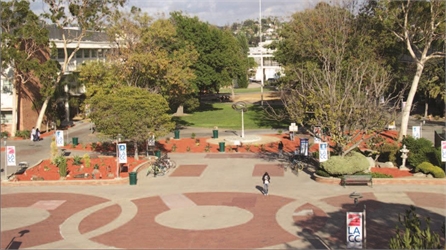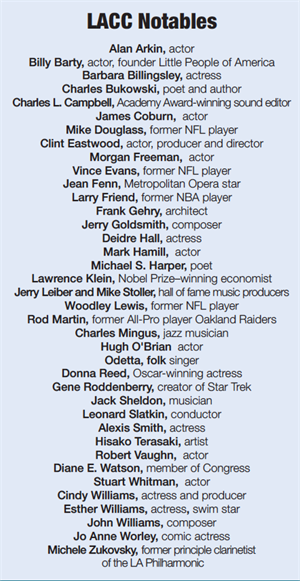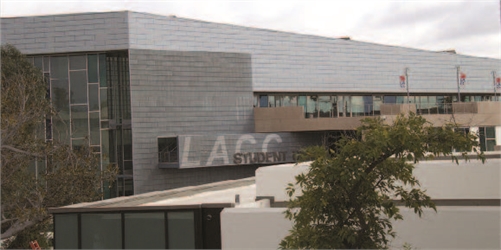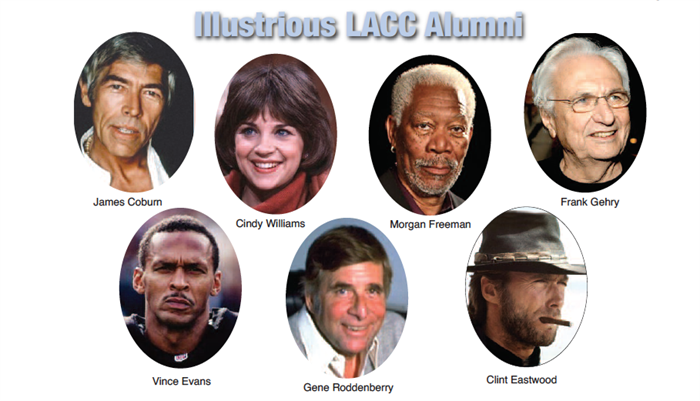No video provided.
Los Angeles City College

The ground beneath the Los Angeles Cit y College (LACC) is one of the most important historic sites for the growth of education in Lo s Angeles. e LACC ground began as farmland and grew with the burgeoning community eager to learn as a training school for teachers, to the early homes of both UCLA and Cal State Los Angeles before finally finding its place as the first community college in
the city. Los Angeles City College opened its doors in 1929 and within the first semester was already the fourth largest institution in the country. The growth and success have not stopped as ongoing renovations and updated curriculums and opportunities continue to help an impressive list of alumni start and complete their educational path into the future.
 In the 1880’s, the City of Los Angeles population was little more than 11,000 people and higher education was one high school downtown and a Normal school for teacher education.The construction of the Pacific Electric Interur ban Railroad in1909 connected the crowded downtown Los Angeles with the small suburb of farmland and horse and buggy traffic called Hollywood. The building atop Normal Hill, as locals referred to it, eventually became the Los Angeles Central Library while
In the 1880’s, the City of Los Angeles population was little more than 11,000 people and higher education was one high school downtown and a Normal school for teacher education.The construction of the Pacific Electric Interur ban Railroad in1909 connected the crowded downtown Los Angeles with the small suburb of farmland and horse and buggy traffic called Hollywood. The building atop Normal Hill, as locals referred to it, eventually became the Los Angeles Central Library while
the doors to the relocated Normal School, built on farmland previously owned by Dennis Sullivan, opened in 1914 with nine brick buildings. One of its first buildings, the administration building, sits where Mr. Sullivan’s farmhouse used to reside.
In 1917, due t o the demand fo r its own lo cal university, the LA Board of Education began lobbying the state and by 1919 their efforts were rewarded when a bill allowed the Normal School to become the southern branch of the University of California Berkeley. Students, however, were unable to get
their degrees from this southern branch until 1925, thanks to the growing enrollment. By 1927, it became obvious that the University of California at Los Angeles or UCLA as it became known, had outgrown the Vermont Avenue location and relocation to the Westwood area began. In 1929, UCLA officially opened the doors at the new Westwood location, leaving behind a campus that the LA Board of Education purchased for $700,000 that would soon become the first community college in the city of Los Angeles.
Los Angeles Junior College, or as it is now known, Los Angeles City College or LACC, opened its doors on September 4, 1929, to 1,350 students. LACC’s president, former Hollywood High School Principal Dr. William Henry Snyder, handpicked each of the first 54 faculty members. The curriculum
included civic health, engineering, general business, secretarial science and social arts. The college had an open door policy and did not charge tuition. This helped locals continue their college or vocational education whenever the economy was on a decline. During the Depression, with no money to go to University and jobs being unavailable, students would find themselves at LACC and enrollment continued to grow. As growth came, so did the opportunities. The college instituted programs including a mortuary curriculum and a nursery tending program as well as becoming the first west coast college to provide a full-scale opera production training. LACC continued to help residents find hope in trying times.
Enrollment took a dive during World War II and faculty had to look for jobs elsewhere. However, the school began offering evening classes and helped the war effort by providing courses for the military. After the war ended, LACC welcomed veterans under the G.I. Bill. Now, unlike previously when students came for vocational purposes, the veteran student body came to prepare for transferring to a University. In 1947, the college began a new experiment and formed a four-year school on campus called the Los Angeles State College of Applied Arts and Sciences. The hope was that this would provide a flexible vocational curriculum that could last from one to four years. Though an admirable idea, the experiment was cumbersome with two different schools on one campus and ended in 1955
when the four-year school moved east and became California State University at Los Angeles. In 1954, LACC received its first accreditation as a junior college.

While the buildings had a construction overhaul, the school continued to make academic strides. In the 1950s, with Dr. John Lombardi as president, the school integrated with African American faculty and by the end of the 1960s, LACC was no longer a predominantly Caucasian school. With a growing number of students from other ethnicities, new occupational programs included dental assisting, occupational therapy, nuclear medicine, human services, and computer technology.
By 1965, LACC’s library was the largest community college collection on any campus in the country with 115,872 volumes. In the 1970s, as immigrants continued to settle in Los Angeles, the college added more Englishas- a-second-language classes and hosted multicultural celebrations. In 1978, Dr. Stelle Feuers became the college’s first woman president and was the first of many to struggle
with diminishing resources due to the changing economy. The 1980s and 90s were met with inadequate funding and by 1985, LACC as required to charge enrollment fees. The Los Angeles City College Foundation, established in 1968, continues to increase the educational opportunities available to students by managing existing funds and raising new funds for academic programs. It works to find resources for unfunded programs and financial changes that the school and students may endure. Most recently, a $10.1 million donation to LACC from the Herb Alpert Foundation makes studies for music majors tuition-free.
As students continued to flourish, a $300 million construction bond helped LACC find its way into the
millennium and the current ongoing construction project (including the student service building scheduled for completion in October) continues to meet the enrollment and curriculum needs of students. Growing technology and careers continue to inspire the curriculum. When Dr. William Henry Snyder was President in the inception of LACC, his mission for the college was two-fold: to provide career training coupled with general education fields that do not require a four-year university
degree and offer the first two years of transfer. This mission is still largely met today with a curriculum inspired by the growing technology and career goals of potential students as well as the LACC STEM program supporting students who plan to transfer to a four-year University.
Dennis Sullivan’s farm provided the land that has now supported over 100 years of inspiring educational beginnings, notable alumni, and innovative approaches to education. LACC opened its doors 87 years ago and has welcomed millions of students and faculty members willing and eager to take leaps and bounds in the education offerings that LACC has and will continue to offer
in the historic Hollywood, California, where dreams of all kinds become reality.
